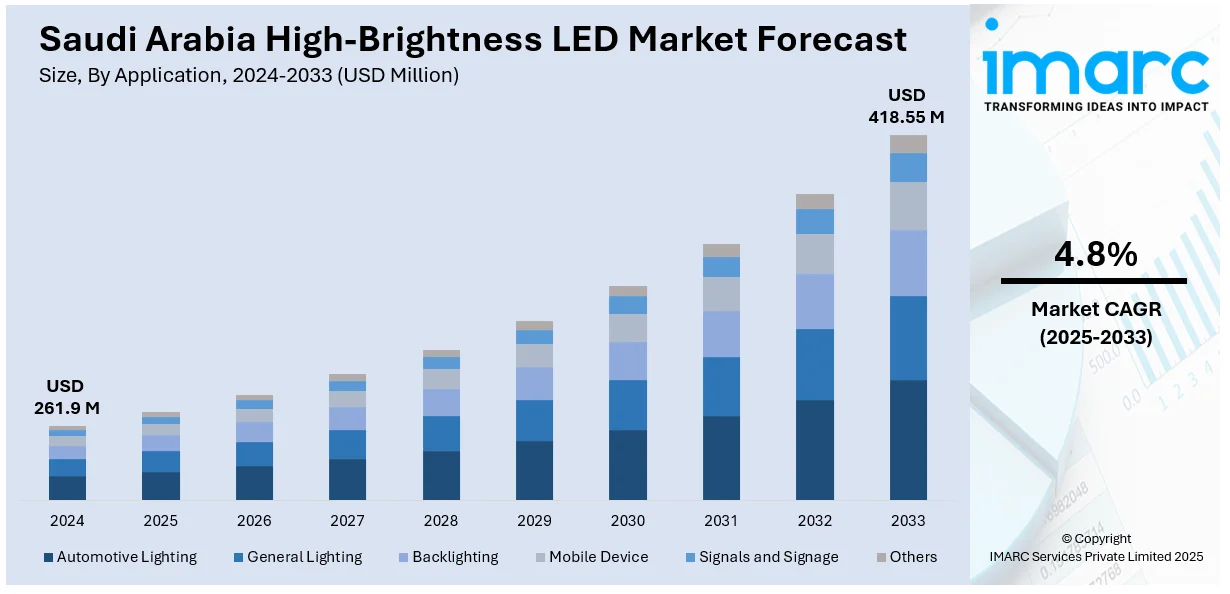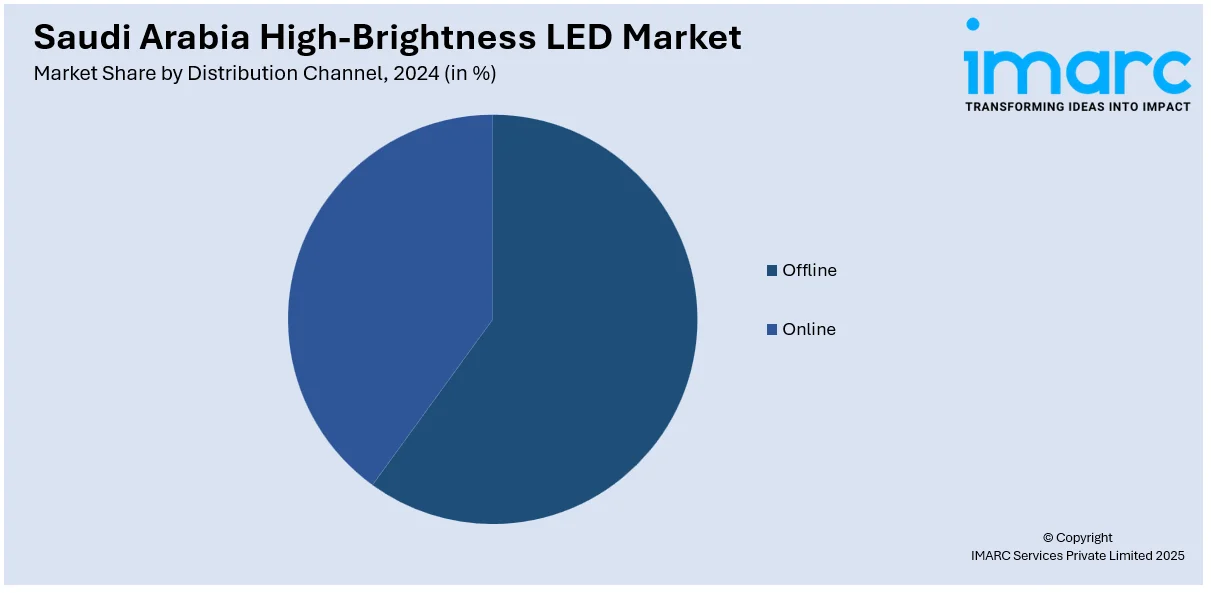
Saudi Arabia High-Brightness LED Market Size, Share, Trends and Forecast by Application, Distribution Channel, Indoor and Outdoor Application, End-Use Sector, and Region, 2025-2033
Saudi Arabia High-Brightness LED Market Overview:
The Saudi Arabia high-brightness LED market size reached USD 261.9 Million in 2024. Looking forward, IMARC Group expects the market to reach USD 418.55 Million by 2033, exhibiting a growth rate (CAGR) of 4.8% during 2025-2033. Growing demand for energy-efficient lighting, government initiatives promoting sustainable infrastructure, expansion of smart cities, rising adoption in automotive and display technologies, and declining LED prices boosting affordability across commercial, residential, and industrial applications are some of the factors contributing to Saudi Arabia high-brightness LED market share.
|
Report Attribute
|
Key Statistics
|
|---|---|
|
Base Year
|
2024
|
|
Forecast Years
|
2025-2033
|
|
Historical Years
|
2019-2024
|
| Market Size in 2024 | USD 261.9 Million |
| Market Forecast in 2033 | USD 418.55 Million |
| Market Growth Rate 2025-2033 | 4.8% |
Saudi Arabia High-Brightness LED Market Trends:
Thermal-Regulating Coatings Driving Efficient Street Lighting
Saudi Arabia is embracing material innovations that improve the performance of high-brightness LEDs used in street lighting. A new nanoplastic coating enables better heat dissipation by allowing infrared light to escape while reflecting visible light. This leads to cooler operation, enhanced energy efficiency, and longer product lifespan. By addressing the thermal challenges posed by the region’s hot climate, this development supports more sustainable and reliable lighting solutions. The use of such advanced coatings is gaining attention for its potential to reduce energy consumption and maintenance demands, marking a shift in how lighting systems are engineered for urban infrastructure in high-temperature environments. These factors are intensifying the Saudi Arabia high-brightness LED market growth. For example, in March 2025, researchers from King Abdullah University of Science and Technology (KAUST) and King Abdulaziz City for Science and Technology (KACST) developed a nanoplastic coating, nanoPE, for LED streetlights. This material enhances heat dissipation by allowing infrared light to escape while reflecting visible light, leading to cooler operation and improved efficiency. In tests, nanoPE reduced LED temperatures by up to 7.8°C, indicating potential for more sustainable street lighting in Saudi Arabia.

Material Innovation Paving Way for Climate-Resilient LED Solutions
Efforts to optimize lighting performance in Saudi Arabia are steering toward climate-adaptive design, particularly through breakthroughs in material science. Recent innovations involve the application of specialized coatings that improve how high-brightness LEDs manage heat. By selectively controlling the transmission and reflection of light wavelengths, these coatings reduce internal buildup of thermal energy without compromising illumination. This passive cooling approach minimizes the strain on LED components, helping them function more efficiently under harsh environmental conditions. In regions like Saudi Arabia, where extreme heat can degrade performance, such materials offer a practical path toward maintaining consistent lighting quality with reduced energy input. The focus is not just on brightness, but on thermal resilience and operational stability. These advances signal a shift in priorities, from conventional energy-saving methods to solutions that adapt lighting systems to local climates, supporting the broader goal of sustainable infrastructure development across the country.
Saudi Arabia High-Brightness LED Market Segmentation:
IMARC Group provides an analysis of the key trends in each segment of the market, along with forecasts at the country and regional levels for 2025-2033. Our report has categorized the market based on application, distribution channel, indoor and outdoor application, and end-use sector.
Application Insights:
- Automotive Lighting
- General Lighting
- Backlighting
- Mobile Device
- Signals and Signage
- Others
The report has provided a detailed breakup and analysis of the market based on the application. This includes automotive lighting, general lighting, backlighting, mobile device, signals and signage, and others.
Distribution Channel Insights:

- Offline
- Online
A detailed breakup and analysis of the market based on the distribution channel have also been provided in the report. This includes offline and online.
Indoor and Outdoor Application Insights:
- Indoor
- Outdoor
The report has provided a detailed breakup and analysis of the market based on the indoor and outdoor application. This includes indoor and outdoor.
End-Use Sector Insights:
- Commercial
- Residential
- Industrial
- Others
A detailed breakup and analysis of the market based on the end-use sector have also been provided in the report. This includes commercial, residential, industrial, and others.
Regional Insights:
- Northern and Central Region
- Western Region
- Eastern Region
- Southern Region
The report has also provided a comprehensive analysis of all the major regional markets, which include Northern and Central Region, Western Region, Eastern Region, and Southern Region.
Competitive Landscape:
The market research report has also provided a comprehensive analysis of the competitive landscape. Competitive analysis such as market structure, key player positioning, top winning strategies, competitive dashboard, and company evaluation quadrant has been covered in the report. Also, detailed profiles of all major companies have been provided.
Saudi Arabia High-Brightness LED Market News:
- In January 2025, King Abdulaziz City for Science and Technology (KACST) successfully localized and developed blue light-emitting diode (LED) technology, which is used in modern energy-efficient lighting applications. This achievement reflects the National Laboratory's efforts to establish infrastructure to support research, development, and innovation.
Saudi Arabia High-Brightness LED Market Report Coverage:
| Report Features | Details |
|---|---|
| Base Year of the Analysis | 2024 |
| Historical Period | 2019-2024 |
| Forecast Period | 2025-2033 |
| Units | Million USD |
| Scope of the Report |
Exploration of Historical Trends and Market Outlook, Industry Catalysts and Challenges, Segment-Wise Historical and Future Market Assessment:
|
| Applications Covered | Automotive Lighting, General Lighting, Backlighting, Mobile Device, Signals and Signage, Others |
| Distribution Channels Covered | Offline, Online |
| Indoor and Outdoor Applications Covered | Indoor, Outdoor |
| End-Use Sectors Covered | Commercial, Residential, Industrial, Others |
| Regions Covered | Northern and Central Region, Western Region, Eastern Region, Southern Region |
| Customization Scope | 10% Free Customization |
| Post-Sale Analyst Support | 10-12 Weeks |
| Delivery Format | PDF and Excel through Email (We can also provide the editable version of the report in PPT/Word format on special request) |
Key Questions Answered in This Report:
- How has the Saudi Arabia high-brightness LED market performed so far and how will it perform in the coming years?
- What is the breakup of the Saudi Arabia high-brightness LED market on the basis of application?
- What is the breakup of the Saudi Arabia high-brightness LED market on the basis of distribution channel?
- What is the breakup of the Saudi Arabia high-brightness LED market on the basis of indoor and outdoor application?
- What is the breakup of the Saudi Arabia high-brightness LED market on the basis of end-use sector?
- What is the breakup of the Saudi Arabia high-brightness LED market on the basis of region?
- What are the various stages in the value chain of the Saudi Arabia high-brightness LED market?
- What are the key driving factors and challenges in the Saudi Arabia high-brightness LED?
- What is the structure of the Saudi Arabia high-brightness LED market and who are the key players?
- What is the degree of competition in the Saudi Arabia high-brightness LED market?
Key Benefits for Stakeholders:
- IMARC’s industry report offers a comprehensive quantitative analysis of various market segments, historical and current market trends, market forecasts, and dynamics of the Saudi Arabia high-brightness LED market from 2019-2033.
- The research report provides the latest information on the market drivers, challenges, and opportunities in the Saudi Arabia high-brightness LED market.
- Porter's five forces analysis assist stakeholders in assessing the impact of new entrants, competitive rivalry, supplier power, buyer power, and the threat of substitution. It helps stakeholders to analyze the level of competition within the Saudi Arabia high-brightness LED industry and its attractiveness.
- Competitive landscape allows stakeholders to understand their competitive environment and provides an insight into the current positions of key players in the market.
Need more help?
- Speak to our experienced analysts for insights on the current market scenarios.
- Include additional segments and countries to customize the report as per your requirement.
- Gain an unparalleled competitive advantage in your domain by understanding how to utilize the report and positively impacting your operations and revenue.
- For further assistance, please connect with our analysts.
 Request Customization
Request Customization
 Speak to an Analyst
Speak to an Analyst
 Request Brochure
Request Brochure
 Inquire Before Buying
Inquire Before Buying




.webp)




.webp)












